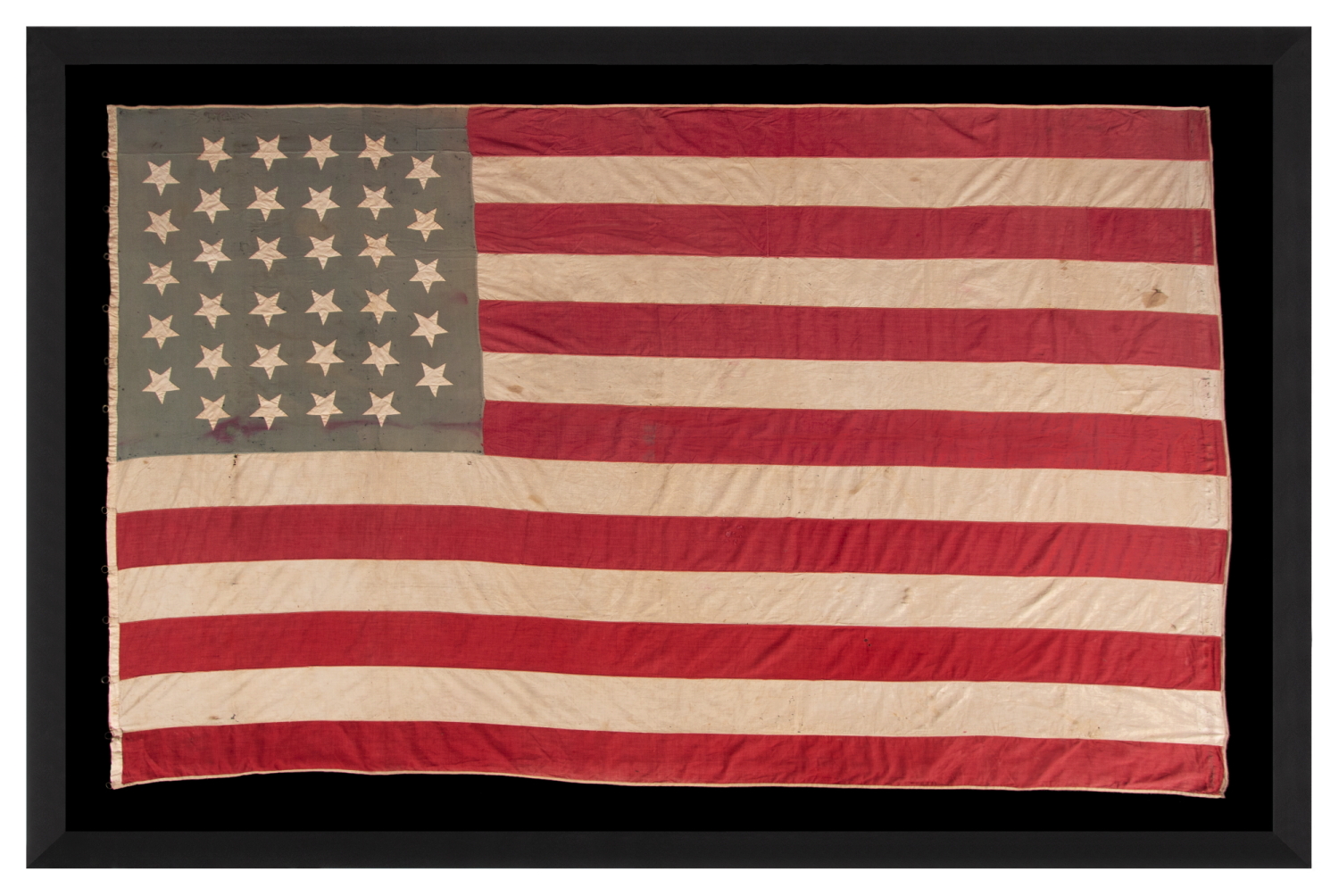


| 34 HAND-SEWN, UPSIDE-DOWN STARS ON A HOMEMADE, ANTIQUE AMERICAN FLAG WITH A VARIANT OF WHAT I HAVE CLASSIFIED AS A “GLOBAL” PATTERN, ON AN INTERESTING, SEAFOAM BLUE CANTON; REFLECTS KANSAS STATEHOOD, OPENING TWO YEARS OF THE CIVIL WAR, 1861-1863 |
|
| Web ID: | 34j-1026 |
| Available: | In Stock |
| Frame Size (H x L): | Approx. 66" x 104" |
| Flag Size (H x L): | 56.5" x 94" |
| Description: | |
| 34 star American national flag, homemade and with an arrangement of stars in what I have termed a “global” pattern, because the configuration bears some resemblance to the profile of a global map. Though similar patterns are sometimes seen in printed parade flags in the 34 star count, (often with secondary, elliptical designs created by the star placement within the rows, which makes them look even more like global maps,) variations of this pattern are rarely encountered in flags with pieced-and-sewn construction, like this example. One notable exception can be found in a scarce number of regulation, Union Army, Civil War battle flags, primarily carried by units hailing from the Midwest and serving in the war’s Western Theater. Though the specific history of this particular flag has been lost to time, the use of this pattern within that general region is suggestive of like geographic origin of this example. Homemade and with wonderfully-hand-sewn, cotton stars, double-appliqued (applied to both sides), note the interesting color of the merino wool canton, which faded to an interesting seafoam blue-green. Also note how the stars are oriented so that they are upside-down on their vertical axis, with two points up instead of one. No one knows if this positioning bore any particular meaning. Both modern notions of the correct orientation of a star, and the present official design of the American flag, dictate that the stars should have one point directed upward. Since there was no official design for the flag until 1912, it may be that the maker of the flag did not consider any particular position to be right-side-up or upside-down. During the mid-19th century, it was not uncommon to see stars pointing any which way, varied throughout the design. Whatever the case may be, the upside-down feature present here adds an element of interest to its visual presentation. The stripes of the flag are made of plain weave cotton that has been pieced and sewn with treadle stitching. The canton was hand-stitched to the striped field, which was constructed in two sections. The 7 stripes next to the canton were joined to the 6 below them via both hand and treadle stitching. There is a fine, hand-sewn, cotton binding along the hoist with a series of tiny brass rings hand-stitched at regular intervals. A narrow binding, made of twill cotton tape, is hand-sewn around the remainder of the perimeter. This was an unusual choice by the maker, likely made with hope for increased strength and longevity of the textile. Most flag makers did not bind the top, bottom, or fly ends, probably because it would make the flag heavier, which was more likely to accelerate damage than prevent it. What the bound edge did accomplish, however, is to produce a scarce trait that often contributes positively to a flag’s graphics, which means that it contributes to the most important reason why early American flags are appreciated and collected. Kansas was admitted into the Union as the 34th state on January 29th, 1861, about 2 ½ months before the Confederate assault on Fort Sumter that marked the beginning of the Civil War. The 34th star was officially added on July 4th of that year, but most flag makers would have added a 34th star with the addition of Kansas in January. The star count remained official until July 4th, 1863, and 34 star flags would have generally been produced until the addition of West Virginia in June of that year. All-in-all, a wonderful, homemade flag of the early Civil War period, with interesting colors, hand-sewn stars in an interesting and unusual configuration, and an overall beautiful presentation. Mounting: The flag was mounted and framed by us in-house. We take great care in the mounting and preservation of flags and related textiles and have preserved thousands of examples. For 25 years we have maintained our own textile conservation department, led by a master’s degree level graduate from one of the nation’s top programs. The black-painted, hand-gilded and distressed molding is Italian. The background is 100% cotton twill, black in color, that has been washed and treated for colorfastness. The glazing is U.V. protective acrylic (Plexiglas). Feel free to contact us for more details. Condition: There is minor to modest fading and there are a few extremely minor stains, but there are no serious condition issues. |
|
| Video: | |
| Collector Level: | Advanced Collectors and the Person with Everything |
| Flag Type: | Sewn flag |
| Star Count: | 34 |
| Earliest Date of Origin: | 1861 |
| Latest Date of Origin: | 1863 |
| State/Affiliation: | Kansas |
| War Association: | 1861-1865 Civil War |
| Price: | Please call (717) 676-0545 or (717) 502-1281 |
| E-mail: | info@jeffbridgman.com |
 |
|